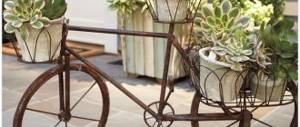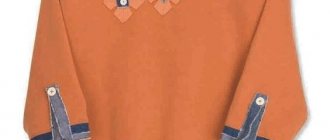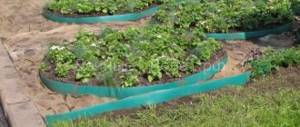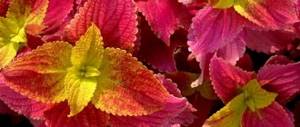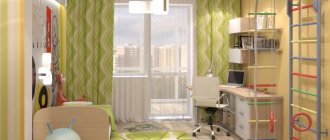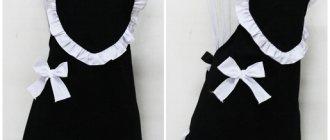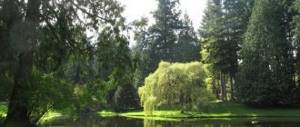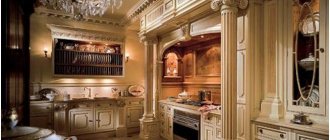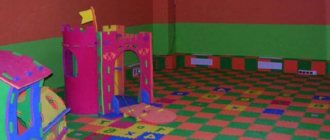Various information stands in kindergartens are necessary for a more competent approach to preschool education for children. Most of these devices are designed to convey certain, necessary information to children, to organize an exhibition of drawings or applications and, of course, to post information for parents.
You can make stands for a preschool educational institution with your own hands, as it is not at all difficult, and the materials for decoration can be found in every home.
So, let’s set up a stand in the kindergarten with our own hands.
What can a stand be made from?
First of all, you need a foundation. This can be a sheet of plywood or fiberboard covered with colored, wrapping or decorative paper.
The main thing here is originality and a general theme, that is, all stands in the group must be decorated in the same style.
Nowadays, you can easily find an organization for the production of information stands if the institution’s staff or parents have absolutely no time for this.
Purpose of stands in preschool educational institutions
Do-it-yourself kindergarten stands must correspond to the theme of the information posted on them.
For example, for parents, information boards contain information about the educational processes in the kindergarten, about the personal reception schedule for teachers and the head, and for children - the daily routine, duty schedule and various educational information.
Examples of group design
How the area in the kindergarten will be designed depends on its purpose.
For example, when decorating an artistic zone - a corner of artistic creativity - the following materials are used:
- colour pencils;
- paints;
- paper;
- tassels;
- water jars;
- plasticine;
- markers;
- decorative elements or finished works of children (as an example).
The art corner helps develop children's creative abilities and cultivates aesthetic taste.
When decorating a book corner, it is advisable to use:
- bookcase;
- table;
- several chairs (2–4);
- books;
- Pictures.
Books should be changed depending on the topic being studied, relevance, and children’s interests (for example, according to the change of seasons, certain dates). It is optimal to install another material once every 2–2.5 weeks. In such a zone, a child in a calm environment will be able to study a book that interests him, chat with it longer, and look at the illustrations.
The reading corner displays books for various purposes.
The ecological corner teaches children to love nature and increases their knowledge about the environment. For zoning the following will be used:
- houseplants;
- animal figurines;
- animals (if the conditions of the institution allow: guinea pigs, rabbits, etc.);
- books about nature;
- watering cans;
- craft paper;
- shovels for the ground.
It is necessary to instill in children a love of nature and respect for the environment.
DIY stands for children's crafts
Such a stand can be made from a large sheet of plywood covered with white glossy paper so that children's drawings and crafts do not get lost on the colored background.
The size of the stand depends on the number of people in the group and must accommodate the work of all students, without exception.
Thematic exhibitions can be supplemented with decorative elements, for example, a stand for displaying autumn drawings can be decorated with yellowed leaves, for New Year’s - with snowflakes.
The kindergarten group is the place where the child spends the vast majority of his time.
It's always nice to go to a place where you feel comfortable. How to create a warm, kind and bright atmosphere here so that you want to come back here? Comfort can be achieved through little things, which is why you should pay attention to them.
As early childhood educators, we often hear a question parents ask their children: “What did you do in kindergarten today?” or “What did you do today?” To make it more interesting for children to talk about the work done, it is advisable to hang children's creativity on display. For this purpose, the idea came up to use individual wallpaper frames that can be hung in the dressing room or in the hall, thus organizing a mini-exhibition of children's art. Making them is very simple and cost-free.
Materials: thick cardboard, beautiful wallpaper, glue, scissors, newspaper.
Progress of work (for creative works in ½ A4 sheet format measuring 21.5x15 cm). From thick cardboard we cut out the base for the frame (a rectangle measuring 19x26 cm) and the frame itself (inner rectangle measuring 20.5x14.5 cm, outer rectangle 24.5x18.5 cm). We twist 4 tubes of the required thickness from newspaper (approximately half a sheet of newspaper) and glue them around the perimeter of the frame. We wallpaper the base and frame with newspaper tubes. The glue should be applied only to the edges of the wallpaper to make the frame appear more voluminous. Glue the frame to the base so that the top side remains free of glue (the child’s work will be inserted into it). Place under a press until completely dry.
Constantly changing the contents of the frames always makes the group look bright and impressive.
Sometimes parents, coming to kindergarten for such a mini-exhibition, are unable to determine what their child has created, especially in younger groups. Then you need some kind of informant who reveals the topic of modeling, drawing, design, appliqué or children's design.
The idea arose to make a “Information House”.
You can make it from a box, carefully pasting it over and decorating it as you wish. Place a pocket window on each side of the house to indicate the theme of the work.
Order is the key to any comfort. Therefore, the idea arose to put some things in cardboard organizers to maintain it. They are convenient for arranging literature by section of the program, children's books, and for safely storing pencils or sheets for children's creativity. You can make these organizers from a cardboard box of a suitable size by cutting off the corners, pasting them over and decorating them to your liking.
If there is not enough space in a kindergarten group, you can make a portable corner for sand therapy, because it is so necessary for children.
It turns out that you can not only play with sand, but also learn and have fun. Taking a plastic container, divide it into two parts: pour sifted clean sand into one, and stones (beans, acorns, chestnuts, large buttons) into the second.
Games that you can play with the sand therapy corner: laying out a certain pattern (flower, geometric shapes, house, etc.); drawing with a finger (sun, snake), palm (octopus, tree), fist (animal tracks), edge of the palm (paths); stick drawing; burying and unearthing objects (find out by touch what is hidden in the sand); “pouring” a slide, path, snowdrift, etc.; construction of a farm, desert, jungle with appropriate toys; modeling from wet sand (balls, pancakes); free activity of the child. For a variety of games you need: a sprayer with water, sticks, small plastic or rubber toys.
It is often necessary to arrange something: be it an invitation to a New Year's party or a postcard for March 8th. And every time I want to be more original than the last.
Lost Items Stand
Such a stand is very relevant for a kindergarten, since children often lose their things. This could be a small rectangular board with a colorful, catchy inscription and hooks on which lost items will be placed.
Take a look at the photo of a children's stand of lost things, made with your own hands; in our opinion, it is very useful in a kindergarten.
It is better to place this stand in the locker room so that parents can see it, because children cannot always recognize their item, especially for younger groups.
Bedroom in kindergarten
Quiet hour for a child is a quiet horror. Convincing your child of the benefits of sleeping during the day is difficult. Therefore, it is important to create conditions in the group that promote relaxation and good rest.
Drawings on the walls in the kindergarten bedroom
The bedroom for a kindergarten group should be relaxing, but not gloomy, which is influenced by the choice of colors and patterns on the walls. Pastel colors, which are selected by the amount of dye in water-based paint, are soothing. The use of several shades for a bedroom in a kindergarten group is allowed if they are close in tone. Sharp transitions activate motor reflexes and excite the body. If the design requires it, then a bright color is used to accent a small area.
Light shades of lilac look harmonious in the bedroom of a kindergarten group. Unobtrusive patterns with smooth lines do not focus children's attention on themselves, reducing the time it takes to fall asleep. You can place cartoon characters on the walls. They are drawn under a stencil in one tone, without highlighting facial features. Such images are thought-provoking, but do not activate the areas of the brain responsible for wakefulness.
The images are also applied to the ceiling of the kindergarten group’s bedroom. In this case, it is easier for the child to keep a picture of the design in his head.
In groups of private kindergartens, a personal drawing is applied near the child’s crib. The child will quickly find his sleeping place and will have his own cozy corner.
A sky theme with characters floating on clouds is welcome, as shown in the photo above. In the pictures, objects that can be counted are placed in groups. Their number depends on the child’s abilities.
There can be only one drawing in a group's bedroom. In this case, the surfaces of the walls and ceiling are painted in the same tone, which creates monotony and relaxes the child’s attention.
Curtains for bedroom
The group's bedroom is not a playroom, so it requires less lighting. This can be achieved with curtains. For the sunny side, thick textiles are purchased. It protects from bright rays of light and cools the room, since surfaces are not heated by infrared radiation. Tulle and curtains are combined over a large area. Roman day-night blinds are made from two types of fabric. One has more capacity than the other. What is needed when cleaning or refurbishing a kindergarten group’s bedroom.
A suitable color for the curtains of the group would be olive or green. Peach and blue have a calming effect. Hinges and holders are matched to the color of the curtains. The bedroom windows of the kindergarten group, facing north, are protected with light curtains that let in light, as the situation will seem gloomy.
Colored vertical blinds will create a pleasant atmosphere in the kindergarten bedroom. An option is available with alternating lamellas of light and dark colors. They are easier to maintain, since dust is removed and stains are eliminated locally without dismantling the elements. Horizontal blinds are combined with tulle and act as blackout curtains.
Beds for kindergarten
Most of the child's day is spent in the kindergarten group. At this time, posture and physical abilities are developed. Therefore, when designing a group yourself, it is important to choose the right furniture, especially beds for the bedroom. If this is not done, the consequences will be scoliosis and more complex curvatures of the spine.
The design of the beds differs in tiers, the presence of sides and the height of the backrest. In groups where the bedrooms are small, but there are many children, bunk beds are used. Some tiers are installed one above the other, or are made in the form of drawers, as can be seen in the photo above. The second option is safe, because if a child falls, he will roll to the previous level and not fall to the floor.
Group bedrooms use combined beds with high sides. In this case, a neighbor does not interfere with your comfortable rest, since a partition separates the children.
High backs also delimit personal space. They are used when placing beds in a row, with a distance between adjacent ones. The furniture is made of chipboard or MDF. Solid wood is more environmentally friendly, but is used less frequently, since the cost of the set is three times more expensive than from particleboard material.
Lamination for group beds is selected in light colors. The second tier is equipped with a high side to prevent the child from climbing over the edge and getting injured. The width and length are selected according to the average indicators for the age category of the group in kindergarten. The bed of the cribs is made of slats or plywood. In the first case, the surface absorbs body movements during sleep, which reduces the load on the spine.
The arrangement of beds in a group's bedroom plays a role. Each child should have free access to their seat to go to the toilet if necessary. Sleeping places are not placed close to the outer wall of the group's bedroom, because due to its temperature the baby will catch a cold. Beds should not be installed in the vicinity of heating devices, since dry air comes from them. It affects the child's respiratory system, causing respiratory diseases. A draft from a window or door is a cause of colds, so when arranging beds, it is important to take this fact into account.
Note! According to the standards, there are three sets of changeable bed linen and two mattress covers per child.
Information stands for kindergarten
Information stands for kindergarten can also be made with your own hands. Their distinctive feature is the presence of pockets for sheets of information.
As a rule, kindergarten employees must convey a lot of information to parents every day, which is not always possible to remember. Therefore, an information board is an excellent option for a preschool.
During production, it should be taken into account that access to the pockets must be free, so that teachers can easily change the information in them to the current one.
As decorative elements, flowers, butterflies, animals, cartoon characters, and thematic images related to the name of the group can be placed on the information stand.
Information stands may include a list of birthday people for the current month, a schedule of additional classes, a menu for the day, a daily routine, and other important and relevant information for parents.
Decorating a group in a kindergarten with your own hands: ideas for creativity
For you, parents!
This poster should contain file frames with useful information for parents. It is usually hung on the entrance group. On one poster there are columns for filling in for different groups, since usually there is not so much information for parents who can “be patient” and wait for the parents’ attention. Bring something important for the next week, information about upcoming vaccinations, etc...
Nature calendar
The nature calendar is a stand that will help children learn the characteristics of each season. It will be interesting to make images of clothes that are suitable for each weather under the pictures of summer, winter, spring and autumn.
Our crafts
A stand with children's crafts can become the main decoration of each group's room. Of course, children usually take their most favorite crafts with them, but a lot of creations remain in the group, which means they need to be put to use!
Menu for the week
A stand that will be interesting for children to make every week, and interesting for parents to look at every day! After all, nutrition is one of the most important aspects for harmonious child development. This menu poster will definitely be popular!
Favorite holiday
A very interesting stand on which you can hang information about the next birthday person. So both teachers and children will not forget to congratulate him on this memorable day.
Our lockers
It will be useful to hang a stand near children's lockers with information on how to properly put away clothes, as well as in what order to put them on.
Children's educational stands
Making children's educational stands with your own hands is as easy as shelling pears. Topics for daily group activities, the alphabet, and numbers can be posted on such boards.
For junior and middle groups of kindergartens, you can design educational boards with signs of the seasons, for example, make it in the format of a nature calendar.
Also relevant is a board with a clock, which will help kids determine the time and navigate it.
In addition, children will be interested in learning the names of various animals and birds and identifying their places of residence. Children's stands can also display photographs from events held in the kindergarten.
It is always easier for children to perceive information from large and colorful pictures, especially when it is always in sight, so educational and developmental stands must be present in children's institutions.
Theoretical aspects of group design in accordance with Federal State Educational Standards
The design of a group in a kindergarten according to the Federal State Educational Standard should be aimed primarily at ensuring that the space helps the individual development of the child, taking into account the characteristics and interests of each pupil.
Design principles
When preparing for registration, the teacher must take into account the following principles:
- Each zone should be focused on helping in the education, upbringing and development of communication of the child (for example, the drawing zone will have useful elements for the development of imagination, creative thinking, the pictures presented help the development of aesthetic taste).
- The environment should encourage the child to engage in independent activities (the leading role is given to play).
- It is necessary to take into account the interests and hobbies of the pupils: all children are different, and in certain areas they will be able to do their favorite things, uniting in groups if necessary. For example, some people prefer to build structures with Lego, some prefer drawing, while others like motor games.
- Various items should be safe for children in accordance with their age (for example, in the younger group it is recommended to use upholstered furniture and avoid sharp objects).
The design should be flexible so that, if necessary, you can easily change elements (decorations, design objects, stands), adapting to the age and developmental characteristics of the group.
The environment in kindergarten should be comfortable for children and contribute to their development
In the younger group, the main thing is a safe design of the environment. Since at this age children are actively developing movements, but do not yet have sufficient coordination, it is better to use 2/3 of the room’s area for objects. At the age of 3–4 years, sensory development is actively underway; objects should be easy to understand and familiarize with, but at the same time differ in color, texture, and material (inserts, pyramids, lacing, boxes). Playing with sand and clay will help actively explore the world around you. Children in the younger group are attracted to drawing. At this age, wax pencils and finger paints are good for practicing.
In the middle group, role-playing games begin to predominate. The children develop their imagination to a greater extent, this helps them in implementing various game plans. Therefore, it will be useful to add attributes to the design of the environment that help develop the plot of the game (shop, doctor’s appointment, holidays). Dolls of various types and toys in the form of animals will help with this. Cognitive activity is activated in the middle group; in addition to getting acquainted with various materials (sand, wood, clay, water), you can conduct small experiments with them. The development of speech should be accompanied by a large number of books, pictures, as well as technical means (dictaphone, microphone, projector).
In the older group, the design of the zone becomes more complicated. More details are used that children at this age can distinguish. Additional material is added to the plot in games (more details of clothing, objects). The same applies to visual activities (markers, pencils). In addition to fiction, the book corner may contain reference materials and encyclopedias.
What zones can there be?
To create a favorable atmosphere in kindergarten for children, the teacher should consider the relevance and usefulness of the created zone (in accordance with the age of the children, their preferences, seasons, holidays). Depending on the conditions of the kindergarten and the age of the children, different zones or corners can be designed.
Reading corner
The reading area should be equipped with a children's library with selected books on the topic and current issues. It’s good if the kids can constantly have access to a literary corner: in their free time, look through books, various encyclopedias, and children’s magazines. The reading corner should be located next to a window for proper lighting and equipped with a table lamp for evening reading. It is best to change the composition of books every 2–2.5 weeks.
The literature presented must be appropriate to the age and preferences of the children.
A reading corner in kindergarten allows children to have constant access to books
In the first junior group, there should be 4-5 books in the reading corner (and the teacher should have additional copies of the same publications in stock). The following items are suitable:
- books on a thick base with a volume of up to 5 sheets,
- books with dynamic elements,
- books of various formats (halves, quarters, little ones),
- panorama books (with drop-down decorations),
- music books,
- flip books,
- pictures with images of various objects.
The second junior group should also have access to 4–5 books:
- books with hard sheets, as in the first junior group;
- books with regular sheets;
- prints on themes of Russian folk tales.
In the middle group, it is necessary to display 5-6 books with fairy tales familiar to children in the reading area, the rest of the publications should be in the closet. The corner equipment includes:
- books with the same work, but different in design (with illustrations by different artists);
- postcards based on works;
- portraits of famous writers and poets.
The senior group should present 10–12 books. In addition to the corner attributes already added in the middle group, the following are entered:
- homemade books made up of children's stories and drawings;
- encyclopedias;
- albums or illustrations on various topics (Motherland, space, holidays, etc.).
In the preparatory group, books with humorous stories can be included in the reading area and the amount of educational materials (about animals, plants, which children are introduced to in class) can be increased.
Photo gallery: examples of designing a reading area in kindergarten
Fairy tales form the basis of all children's reading
Starting from the middle group, you can complement the book corner with portraits of famous writers
On the shelves, in addition to books, you can place figurines of animals or fairy tale characters, toys
In the older group, homemade books compiled by children are placed in the reading area
In the senior group, the bookshelf is replenished with encyclopedias and educational materials. In the preparatory group of the preschool educational institution, the material in the book corner is significantly expanded
Creative zones
Creativity zones can be placed anywhere - near a window, in a closet, in the reception area. The arts corner will contain paints, albums, plasticine, coloring books, brushes, etc. The music corner can be well decorated with a variety of instruments, cassettes with songs, and portraits of composers. The theatrical area will feature various masks, costumes, fairy tale materials, and audio recordings.
Photo gallery: examples of design of creative zones in preschool educational institutions
In the design of the reception room there is always a place for children’s work and creativity
It is important to arrange the finished works of the children in the form of an exhibition
Pencils, felt-tip pens and other drawing objects should be available in the art area.
The music corner is filled with various instruments, you can also add portraits of composers
Developmental space
Study areas are aimed at educational activities. It is useful to make a math corner with objects in the form of numbers, abacus, and geometric figures. To develop environmental knowledge, create a natural corner where you can conduct experiments with materials: sand, water, plants, and observe the environment. If conditions permit, children will be delighted by a living corner where they can place cages with guinea pigs, hamsters or rabbits.
Photo gallery: examples of design of a training area
The study area is positioned so that the light falls on the desks from the left side
A magnetic board and educational materials should be placed near the wall.
Materials for GCD are placed opposite the tables
The nature corner is not only a decoration for the group, but also a place for children’s self-development. The central place in the ecological corner is occupied by the nature calendar. The nature corner introduces children to the features of the world around them.
One of children’s favorite activities is experimentation. In the experimentation corner there are objects made of various materials: sand, metal, wood, etc.
Game corner
The play area is a mandatory design element. In younger groups, for example, you can place cars, rides and other motor toys in this area. For older children, you can make a Lego corner, place animal figurines, soft toys. In the “Shop” and “Polyclinic” zones, you can organize all kinds of games that will develop children’s social and communication skills.
Children love to play most of all, so a specially designated area for activities is necessary.
Toy dishes are placed in the dining corner. Children will cook lunch here, tea for their dolls, and bake pies in a toy stove. The dining table can be decorated with plastic fruits and vegetables.
Thematic mood zones will help children relax, eliminate stiffness and anxiety, relax and gain strength. In accordance with the Federal State Educational Standard, the design of zones should not only be aimed at active activities of children, but also provide psychological comfort. For example, in the privacy zone there may be a small house, hut, tent, where the child can retire and be alone if he needs it. It is important to create a calm atmosphere: choose pastel colors, dim lighting, use soft objects.
